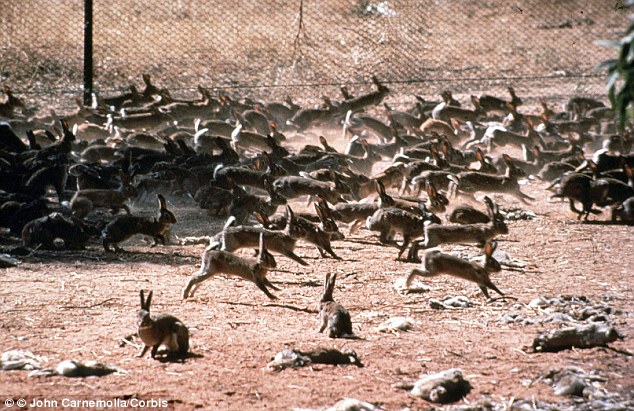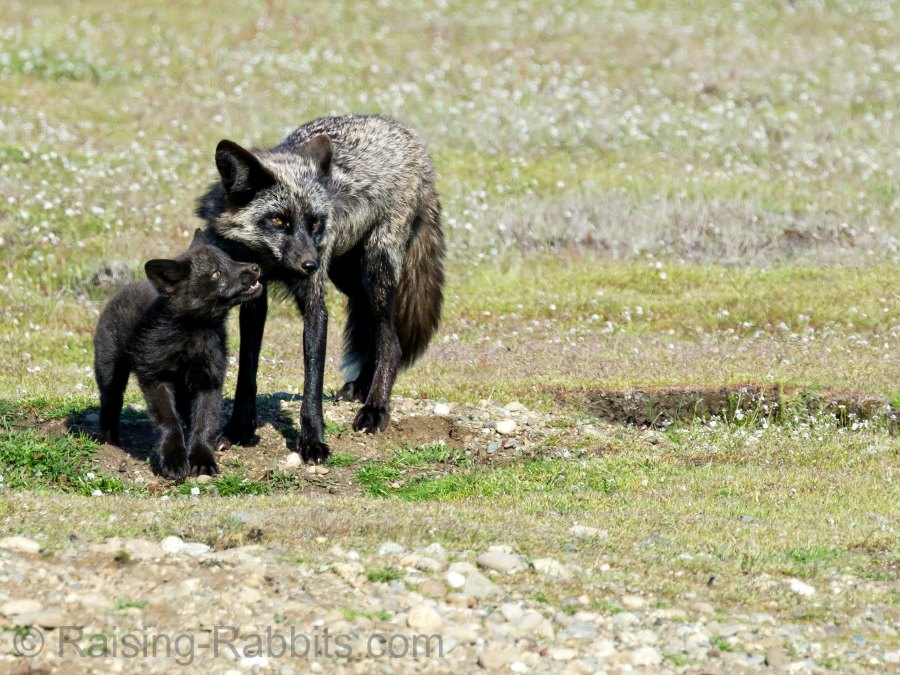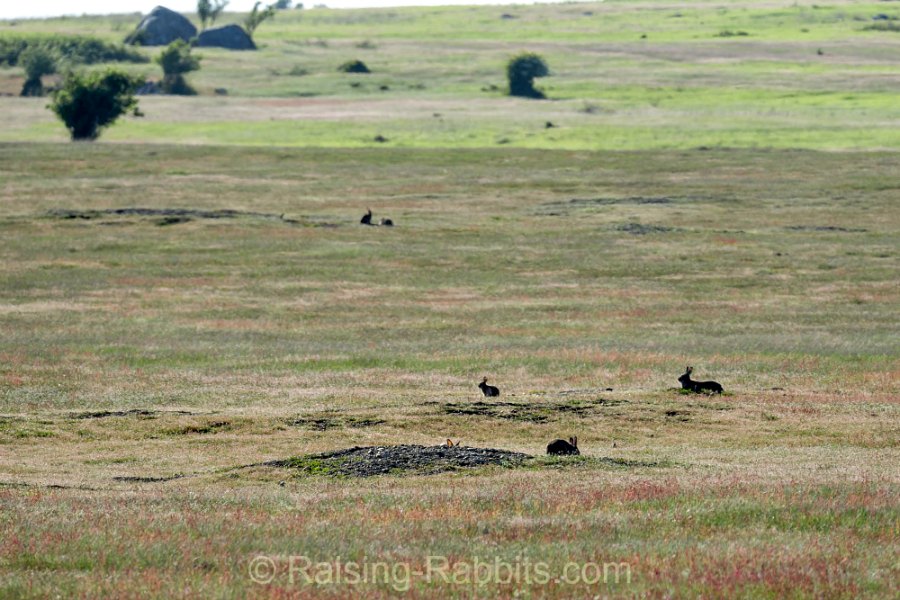RVHD in BC
RVHD in BC: History, details, best practices for disease control, both for controlling the spread of disease, and also to prevent the virus from entering your rabbitry and killing your domestic rabbits.
Rabbit Viral Hemorrhagic Disease is a highly lethal virus that kills in a matter of 1-2 days, turning a healthy rabbit into a dead one seemingly overnight, often with bleeding around the nostrils. The disease goes by several names: Rabbit Hemorrhagic Disease, RHD, RVHD, and Calicivirus are the main ones. These are all the same disease. Recently a new mutation of the virus has been identified as RHVD2. The details about how this virus kills and how to practice quarantine measures can be found on Raising-Rabbits here: Rabbit Hemorrhagic Disease.
Wikipedia presents a very good history of RVHD and overview of the disease.
In February 2018, the Canadian province of British Columbia began experiencing
an outbreak of the deadly RVHD2 strain of the calicivirus in the feral domestic rabbit population in and around Nanaimo BC (especially on the Vancouver Island University campus).
Wild cottontails are immune. These rabbits are domestic rabbits, people's unwanted pets unwisely released into the wild, or rabbits purposely released by animal rights adherents, and which then began breeding and multiplying as only rabbits can do. (Luckily, predators help keep the numbers in check.) In the USA, domestic rabbits, being non-native, are considered an invasive species, and thus illegal to release into the wild.
I have not heard if it is known how this virus was transmitted into the southern BC environment. It is possible to transmit the virus through the purchase of contaminated rabbit meat or rabbit pelts originating from areas where the disease is endemic.
What does RVHD in BC look like?
All you’ll see are dead rabbits. While up to 75% of affected feral rabbits actually die inside their burrows, you'll still see various fluffy rabbit carcasses suddenly littering the fields where feral colonies once thrived (depending on the original size of the rabbit colony).
When notified, Animal Control will haul away the carcasses for testing. As long as the outbreak is active, you're likely to continue to discover dead carcasses on a near daily basis, typically with blood around the nostrils.
 Feral Rabbits on San Juan Island (WA)
Feral Rabbits on San Juan Island (WA)RHD is endemic in Europe and China, but not in BC.
Yet.
But the threat is strongly there. From the feral population around Nanaimo, RVHD in BC spread northward into the Comox region.
Despite rigorous quarantine efforts by several responsible local rabbit breeders, the highly infectious and persistent disease organism jumped from the feral population to the domestic rabbit herds. The entirety of these affected rabbit herds have been euthanized in order to prevent further spread of the disease.
Somehow the virus managed to jump the Salish Sea, possibly on shoes, clothing, or rabbit transport, and made its presence known in the southern BC mainland. Cases cropped up in the Richmond/Delta area near Vancouver BC. A couple rabbits in a rabbit rescue facility in Richmond took sick and died. RVHD2 was verified. As a result, the entire shelter rabbit population were euthanized, the interior cages destroyed, and the facility sanitized.
As of June 2018, the epidemic is ongoing, with cases continuing to be found in the aforementioned areas.
If you see two or more feral rabbits dead (or even one in known affected areas), please immediately contact the local animal control officer or veterinarian so the animals can be removed and tested for RVHD.
If YOU own rabbits, be wise!! Don't go anywhere near the active epidemic areas. If you live near contaminated areas, don't transport your own rabbits anywhere. Practice quarantine religiously until the epidemic has been given the all-clear, and then for a few more months (or a year).
(Misguided) BC Veterinary Plan for Eradicating RVHD in BC
According to statements made by Dewdney Animal Hospital (in comments on their Facebook page): "The most effective way to kill a feral population is to release a virus that kills the feral population while vaccinating the pet population."
This would possibly be effective IF (BIG IF):
- If the virus could kill 100% of all feral rabbits that become infected
- If the vaccine would protect 100% of all rabbits that receive the vaccine.
(The vet hospital seems to have forgotten that rabbits are not only pets, but also livestock animals. It is possible that the livestock rabbit population is larger than the pet population, and every single rabbit older than about 10 weeks of age, whether pet or livestock animal, would need to be vaccinated.)
Unfortunately, no, it is NOT the most effective way. Neither of these points true, and therefore, to follow this plan is to likely guarantee that RVHD in BC will become endemic.
Here is why:
- First: Vaccination confers effective protection in, at best, only 90% of rabbits. This is the case for all vaccines, not just that for RVHD. Vaccinated rabbits will die from RVHD. And eventually, once the virus learns to protect itself by mutating, vaccination will confer less and less protection because the vaccine will match the virus less and less frequently. For example, currently in the human population, whooping cough cases occur primarily IN vaccinated individuals, thanks to mutations in the pathogen. See much more info on how rabbit vaccinations work here (specifically refers to the Bunnyvac for Pasteurellosis, available in the USA, but the principles are identical).
- Second: RVHD will not kill 100% of the rabbits that contract the virus. 99.5% initially, yes. But some rabbits are bound to survive the virus, become immune, and then start multiplying.
We have nothing against feral rabbits, but, as long as they live in the outbreak areas, they become points of infection that can, and will, continue to spread far and wide. The critical goal is to eradicate the virus from the environment, and sadly, this NECESSITATES eliminating the feral population in affected areas, at least for a few years.
Without an effective plan to eradicate 100% of the affected feral rabbit population, BC's efforts are doomed to fail. They are basically accepting the reality of permanent RVHD in BC, continually chasing down and testing dead rabbits, and condemning all rabbit owners to the use of incompletely effective vaccination in order for a chance to keep their rabbits alive.
Raising-Rabbits has received many grieving comments from Australians, for example: "My 3 pet rabbits all died last night. They were fully vaccinated. I don't know why they are dead. I'm heartbroken." All I can offer are my condolences. And it will be this way in BC as well, if we do not bite the bullet right now in order to enjoy our rabbits to the fullest later.
We can be SURE of this outcome by learning from Australia's unsuccessful efforts to eradicate Australian feral rabbit populations.
Australia's Massive Feral Rabbit Problem
 Feral rabbits in Australia, 100 years after the initial release of a dozen rabbits.
Feral rabbits in Australia, 100 years after the initial release of a dozen rabbits.In the early 1800's, British land owners in Australia imported a dozen domestic rabbits, releasing them into the Australian countryside with the intent of later hunting and eating the offspring.
What could go wrong? After all, in Britain, this was the status quo. European rabbits lived everywhere. (They still do.) Some landowners actually kept colonies of rabbits in Britain for this very purpose. The warrens were surrounded by hedgerows and rock fences, and while some rabbits no doubt hopped away or tunneled into other fields, their needs were met inside the warren, reducing the pressure to do so.
What the Australian landowners did not realize was that Australia have no rabbit predators. Within 80 years (circa 1900 or so), those few rabbits had multiplied to 100 MILLION, or more. A hundred million rabbits devastate countrysides. Left to themselves, the entire island of Australia would become a barren, uninhabitable rock with not a blade of grass. People would have to leave the island just to survive, and the rabbits would all finally die for lack of forage.
Australian politicians have over the years released first myxomatosis, then RVHD, and finally RVHD2, into the environment. The viruses had the desired effect.
Almost.
Upon release of the myxomatosis virus, 99.5% of rabbits died.
But do you realize that 0.5% of one hundred million rabbits is still 500,000 rabbits? And those surviving 500,000 rabbits were now more or less immune to Myxy. The rabbit population, of course, rebounded, climbing to 400 MILLION (yikes!), before the government became desperate once again. They tried a new viral onslaught, this time using the RVHD virus, with similar results: A huge die-off, and then the rebound. And recently, as rabbit numbers are climbing yet again, they felt the need to release the new mutated strain, RVHD2.
Here we are in 2018, and the feral rabbit population in
Australia continues to be a gigantic headache. The rabbits are multiplying (like
rabbits) and are fairly immune to all three viral strains. The vast sheep ranches of
Australia and New Zealand all have at least one full-time "rabbiter,"
a hunter specifically tasked with limiting or eliminating (if possible) the
feral rabbit population on the ranch. This is because without a rabbiter, there will not be
enough forage for the cattle. The rabbits will eat it all.
Will RVHD in BC become endemic?
I hope to God no, but the current 'plan' will do nothing to prevent it.
 Foxes on San Juan Island in Washington State prey on the feral rabbit population
Foxes on San Juan Island in Washington State prey on the feral rabbit populationAustralia is a cautionary tale relative to RVHD persisting in the environment if 100% of infected rabbits are not caught and destroyed.
There IS a crucial difference between Australia and British Columbia however: BC has rabbit predators. The feral population is in no danger of burgeoning out of control. But I don't know if this one fact will be enough to change outcomes.
Can we count on predators to kill the 0.5% of affected rabbits that do not succumb to the virus and that go on to become immune? I would hate to gamble on it!
How Best to Respond to the Threat of RVHD?
Eliminating the virus in the environment is the goal. To achieve this, feral rabbits must be 100% eliminated in every affected area. Ideally, the environment would be maintained feral-rabbit-free for up to a year, or longer if necessary to ensure the virus has disappeared from the environment.
Why eliminate all feral rabbits? Because this is the only way to destroy the virus, which is in the feral rabbit population.
There is ample precedent for this approach:
Animal Control authorities always euthanize 100% of domestic and/or shelter populations if even ONE rabbit tests positive for RVHD on the premises.
- The Richmond shelter was completely depopulated when RHD was found there. And in fact the entire caging system was also destroyed.
- The current outbreak of RVHD in BC spread to three show rabbit herds despite excellent quarantine practices; all three herds were 100% depopulated.
A 100% solution was taken on Enderby Island in the south of New Zealand.
Where can I purchase top quality pet rabbit cages?
From Raising-Rabbits, of course!
Raising-Rabbits has partnered with Hostile Hare to bring you cages that exceed our rigorous rabbit housing standards.
We do not produce cages, but we sure know a well-built, predator-proof, baby-safe, bunny-feet-safe cage when we see it! We think Hostile Hare cages will serve you well for years!
Explore the many choices by clicking the logo or this link!
Enderby Island Rabbit Extermination
There is also precedent for the elimination of feral rabbits from an environment.
In 1865, a dozen feral silver-gray rabbits were purposefully released on Enderby Island, the northernmost island in the New Zealand Aukland Islands cluster south of New Zealand. The rabbits were purposely released so they could multiply and be available to feed any who might shipwreck in the area. This they did for the next 100 years, feeding a number of shipwrecked sailors over the years.
For the next century, the Enderby Island rabbit population fluctuated, between "the island is overrun" (1874), to nearly starving out due to overgrazing of the grass (1886). The rabbits learned to eat the mossy plants. In both 1894 and 1927, rabbit numbers were once again burgeoning. In 1934, New Zealand made the decision to remove all non-natural species from the island and make it a natural preserve, but the wheels of government turned slowly.
It was determined in 1987 that the rabbits needed to be exterminated. At the time, 5,000 - 6,000 rabbits populated the tiny 1,700-acre island. The reasons for extermination were listed as rapid destruction of the native environment, and endangerment of the local Hooker sea lion pups, who tended to get trapped in rabbit burrows and then die. Thankfully, they first trapped and rescued 50 Enderby Island rabbits before the rest were destroyed. These are now recognized in New Zealand as a purebred breed.
The last rabbit on Enderby Island was shot and killed in April, 1993.
The Options are no different today: A successful outcome will require a 100% solution, which will require human intervention.
Several years ago I received communication from New Zealand university students tasked with researching the best course of action for eliminating RVHD in New Zealand. I gave them the same recommendations that I offer here: Do not rely on a biologic solution that is not 100% effective. The problem will require human intervention - trap and butcher.
(The carcasses can be used to defray some of the costs. Rabbit meat can be sold, or donated to soup kitchens to feed the poor. It can also be marketed frozen to feed pet dogs and cats. The fur can be marketed as well. There are so many feral rabbits in both New Zealand and Australia that a rabbit products industry could keep rolling for years.)
 Feral rabbits are everywhere in this little corner of San Juan Island. Foxes continually patrol rabbit mounds looking for dinner.
Feral rabbits are everywhere in this little corner of San Juan Island. Foxes continually patrol rabbit mounds looking for dinner.I'm told by the good folks at Dewdney Vet Hospital that killing the ferals "is not politically viable" (their words).
What?
When it comes to the feral rabbit population, suddenly everyone’s brains freeze?
This is no doubt thanks to heavy pressure from radical Animal Rights groups. “It's cruel to kill these cute fluffy innocent animals!”
But I beg to differ - it's actually cruel NOT to eradicate this threat to an entire healthy rabbit population, whether pet or livestock.
It becomes a huge political fiasco. Votes become more important than wisdom, and politicians are suddenly loathe to do the right thing for either the environment or the domestic rabbit industry.
In the house, barn, or in the rabbit rescue facility, this is exactly what the law demands – euthanization of the entire rabbit population. It is the only way to ensure a halt to the spread of the virus.
Why is this solution not required in the feral population of an affected geographic area? Do they really want to condemn the BC region to endemic RVHD (meaning both feral and domestic rabbits dying on a regular basis from RVHD)?
Because if BC Animal Control fail to apply the same policies that work in domestic herds and rabbit rescue facilities, they will by their inaction enable the virus to persist indefinitely.
Take heart rabbit owners and rabbit lovers:
If you REALLY love rabbits, you will do all in your power to support a plan that eliminates this dangerous threat to rabbits from the environment.
- Assist the authorities in their efforts to eradicate the feral rabbit population. This would be a temporary euthanization program for the good of healthy rabbits throughout North America
- Don't dump unwanted rabbits into the wild, at least not for a year or two, or until an all-clear is given
If euthanizing all the cute cuddly, but sick and infected rabbits is too heart wrenching, let's go for Plan B...
A Non-Cull Solution
- Trap all feral
rabbits within a specified radius and house them in a designated local rabbit
rescue facility under strict quarantine.
- Over a few
months (or more), these rabbits will either live or die.
- At some point
when the outbreak is a thing of the past, any surviving rabbits that also test
negative for RHD can be rehomed as needed.
- Strict quarantine measures
would need to be in place. Staff would need to adhere carefully to them, AND also be prohibited from owning or caring for any other rabbits until such time as the virus has been
eliminated from the environment and the quarantine facility.
The good folks at Dewdney Vet Hospital are concerned that human involvement in the process will increase the spread of the disease. I partially agree.
We've already seen 3 cases where rigorous quarantine measures somehow failed to prevent the spread of RVHD in BC to show rabbit herds.
And quarantine measures would be required on multiple levels in order to prevent further spread of RVHD in BC, as long as folks are unwilling to even attempt the eradication of feral populations.
It's risky, but in my opinion it is better than crossing one's fingers and hoping the feral rabbits will all succumb and disappear.
Ongoing Safeguards After Threat Elimination
Once the outbreak has burned itself out:
- Rabbit owners should continue their quarantine measures for a predetermined time frame after the last known case of RVHD in BC has been identified and eliminated.
- Pet rabbits should never be abandoned into the wild, and especially not within the identified radius of the RVHD outbreak for a period of up to a year or more. This gives time for the virus to perish in the environment.
References:
- Rare and Lethal Virus Found in Deceased Nanaimo Rabbits, the First Cases in BC: https://nanaimonewsnow.com/article/570436/rare-and-lethal-virus-found-deceased-nanaimo-rabbits-1st-case-bc
- Province warns rabbit owners about deadly virus on Vancouver Island: http://www.cbc.ca/news/canada/british-columbia/province-warns-rabbit-owners-about-deadly-virus-on-vancouver-island-1.4560587
- Dozens of rabbits to be euthanized at Richmond Animal
Shelter after RHD infection: http://www.cbc.ca/news/canada/british-columbia/richmond-animal-shelter-rabbit-hemorrhagic-disease-1.4615004
- Vaccine against deadly rabbit disease coming to B.C.http://www.cbc.ca/news/canada/british-columbia/rabbit-haemorrhagic-disease-vaccine-1.4600162
- Nanaimo
overrun with feral rabbits: http://www.cbc.ca/news/canada/british-columbia/nanaimo-overrun-with-feral-rabbits-1.3020504
Double-Value Guarantee
Our policy is to always OVER-deliver
on value,
which is why your purchase is fully covered by our
Double-Value
Guarantee.
Go ahead - take any of our e-books for a test drive. Peruse our detailed informational and educational e-books. Examine our plans for building rabbit cages, runs, or metal or PVC hutch frames. Check out the Rabbit Husbandry info e-books.
If you aren't completely satisfied that your e-book purchase is worth at least double, triple or even quadruple the price you paid, just drop us a note within 45 days, and we'll refund you the entire cost. That's our Double-Value Guarantee.
Note: When you purchase your
e-books, they will be in PDF format, so you can download them to any device that
supports PDF format. We advise making a back-up copy to a drive or cloud
account. If the books are lost, you can also purchase another copy from Raising-Rabbits.











New! Comments
Have your say about what you just read! Leave me a comment in the box below.